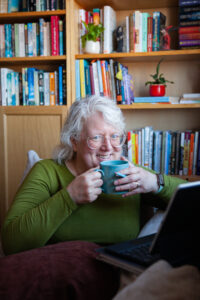What does your garden say?
I love visiting new places, or revisiting and see what changes there are to a well known place.
When someone walks up to your building, or views it online through the wonders of Google maps – what do they see?
A noticeboard? Some posters? A car park or a ‘green oasis’ shared space? Signage inviting them into the garden – perhaps mentioning ‘quiet spaces’ or ‘a peace pole’ or a long list of things not allowed?

Friends House in Euston, London had a garden revamp a few years ago. The rose bushes and a magnolia were replaced with smooth stone benches/edging and turf plus some hardy planting. The garden is a wonderful place to hang out with people during Yearly Meeting (follow that link to see a typical lunchtime gathering).
But there is also a timeline embedded into the pathway, with key dates and a bit of text giving a flavour of what Quakers history includes. There are enough blank stones to allow more to be added. If you want to see more images and read the full timeline – follow the ‘garden revamp’ link above.


Only when we see that we are part of the totality of the planet, not a superior part with special privileges, can we work effectively to bring about an earth restored to wholeness.
Elizabeth Watson, Your God is Too Small, 1996 Tweet
Other meeting houses have been decorated a paved area with community created hand made tiles, have created a community garden, allowed part of their burial ground to be used by refugee groups as allotments, or have reached agreements for local councils to maintain burial grounds and other land owned by the meeting. Click through to read some of these projects and others.
- Nailsworth
- Norton
- Bunhill Fields
- Bridport
- Warwick
- Tottenham
- Malvern – completely open to the public
- Leighton Buzzard
Did you know there is a Quaker Garden Trail?
Gathering in Gardens
It may be that your garden isn’t appropriate for sharing. However, it may be suitable for gathering people together – this doesn’t have to be a large drain on local meeting resources. Some meetings have hired out parts of their garden for forest schools, school sports days, film and fashion shoots.
But a garden can be used to build community within the local worshipping community – inviting everyone to donate a plant and bring a picnic for example. Muswell Hill planted hedges with donated trees and invited the local MPs, Mayor and councillors as well as hirer groups to join in. Another has a orchard where groups come to harvest and then give the meeting juice in return – with most going to other organisations including a local food bank.
What do you do in your garden to express your values and live out your testimonies?
What better way to show our concerns about sustainability, climate change and care of this fragile planet than to make a statement with a biodiverse natural eco-garden
- Rebecca Dyde, Claire King and Clare Barnett (Hartshill LM)

Wendrie Heywood
MBS Founder
A great way to open your gardens to the community is to advertise that they exist. Social media platforms are a great way of engaging with the community. Don’t worry if you don’t know where to start, we have you covered. Join us on Wednesday 7th May at 12.00 noon for a lunch and learn session with the MBS team. This 60-minute session will give you an overview of the basics.
This is a useful session for charities looking to start a presence on social media or build on your existing profile.






